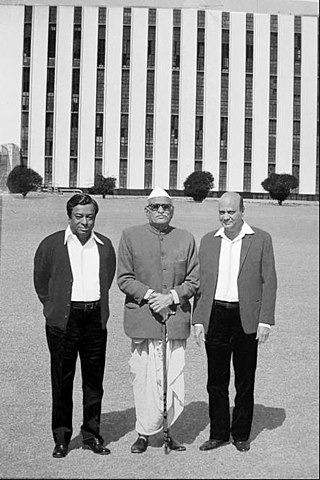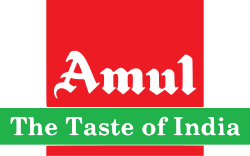Top Qs
Timeline
Chat
Perspective
Amul
Indian state government owned dairy cooperative society From Wikipedia, the free encyclopedia
Remove ads
The Anand Milk Union Limited commonly known as Amul is an Indian dairy brand owned by the cooperative society, Gujarat Cooperative Milk Marketing Federation (GCMMF), based in Anand, Gujarat.[3][4] GCMMF is controlled by 3.6 million milk producers.[5]
Tribhuvandas Kishibhai Patel founded the organisation in 1946 and served as its chairman until his retirement in the 1970s. He hired Verghese Kurien in 1949,[6][7] initially as the general manager, where Kurien guided the technical and marketing efforts of the cooperative. Kurien briefly became the chairman of Amul following Patel's death in 1994, and is credited with the success of Amul's marketing.[8]
Amul spurred India's White Revolution, which made the country the world's largest producer of milk and milk products,[9] and has since ventured into overseas markets.[10]
Remove ads
History
Summarize
Perspective

Amul was founded on 14 December 1946 as a response to the exploitation of small dairy farmers by traders and agents. At the time, milk prices were arbitrarily determined, giving Polson an effective monopoly in milk collection from Kaira and its subsequent supply to Mumbai.[11][12][13]
Frustrated with the trade practices (which they perceived as unfair), the farmers of Kaira, led by Tribhuvandas Kishibhai Patel, approached Vallabhbhai Patel, who advised them to form a cooperative. If they did so, they would be able to directly supply their milk to the Bombay Milk Scheme instead of working for Polson.[14] Sardar Patel sent Morarji Desai to organise the farmers.[12]
Following a meeting in Chaklasi, the farmers formed the cooperative and resolved not to provide Polson with any more milk.[14] Milk collection was decentralised, as most producers were marginal farmers who could deliver, at most, 1–2 litres of milk per day.Cooperatives were formed for each village.[15]
The cooperative was strict that any farmer could become a member, irrespective of their religion, caste, gender, or political affiliation.[16]
By June 1948, the KDCMPUL had started pasteurising milk for the Bombay Milk Scheme. Then-Prime Minister Lal Bahadur Shastri visited Anand to inaugurate Amul's cattle feed factory. On 31 October 1964, he spoke to farmers about their cooperative. After returning to Delhi, he set in motion the creation of an organisation, the National Dairy Development Board (NDDB), to replicate the Kaira cooperative in other parts of India. Under the leadership of Tribhuvandas Patel, in 1973, Amul celebrated its 25th anniversary with Morarji Desai, Maniben Patel, and Verghese Kurien.[17]
The cooperative was further developed through the efforts of Verghese Kurien and H. M. Dalaya. Dalaya's innovation of making skim milk powder from buffalo milk was a technological breakthrough that revolutionised India's organised dairy industry.[18]
With Kurien's help, the process was expanded on a commercial scale, which led to the first modern dairy cooperative at Anand. This cooperative would go on to compete against the established players in the market.[19]
The success of the trio (T. K. Patel, Kurien, and Dalaya) at the cooperative's dairy soon spread to Anand's neighbourhood in Gujarat. Within a short span, five unions in other districts—Mehsana, Banaskantha, Baroda, Sabarkantha, and Surat – were set up, following the approach sometimes described as the Anand pattern.[12]
In 1970, the cooperative spearheaded the "White Revolution" of India. To combine forces and expand the market while saving on advertising and avoiding competing against each other, the Gujarat Co-operative Milk Marketing Federation Ltd., an apex marketing body of these district cooperatives, was set up in 1973. The Kaira Union, which had the brand name Amul with it since 1955, transferred it to GCMMF. Technological developments at Amul have subsequently spread to other parts of India.[20]
In 1999, it was awarded the "Best of All" Rajiv Gandhi National Quality Award.[21] In 2025, Amul was ranked third most valued brand in India in the YouGov India Value Rankings 2025.[22]
Remove ads
Organisation: 3 tiers of hierarchical co-operative societies
Summarize
Perspective
Amul operates on a three-tier co-operative society model of dairy development is a structure, where milk producers form the village level dairy cooperative societies, federated under a milk union at the district level which are further federation as member unions at the state level. Amul at village and district level is managed by the elected officials. The three-tiered structure, known as the "Anand Pattern of co-operative societies", has the following hierarchical levels:[23]
- Village level society - Village Dairy Cooperative Society (VDCS): Milk producers in a village come together to form this primary society, which collects surplus milk and provides support services to its members. Members elect the management council, i.e. village level societies are self-managed by the elected members.
- District level union of societies - District Cooperative Milk Producers Union (DCMPU) or Dugdh Sangh: Village-level societies within a district become members of a district milk union, which is responsible for procuring, processing, and transporting milk. Each village level council with one vote each is member of district level union and they elect the district level council, i.e. district level unions are self-managed by the elected members. Banas Dairy of Banaskantha district and Dudhsagar Dairy of Mehsana district in Gujarat are examples of district level union of societies.
- State level federation of state level unions - State Cooperative Milk Federation (SCMF): The district milk unions within a state are federated under a state-level organization. This federation is in charge of marketing and distributing milk and milk products. In the case of Amul, the state federation is the Gujarat Cooperative Milk Marketing Federation Ltd. (GCMMF). Each district level union with one vote each is a member of state level union and they elect the state level council. The elected state level federation's elected council hires the corporate-style outsider professionals managers to run the operation to give it the professional competitive edge.[23]
- Not part of Amul structure: There are other co-operative societies in India with 4 layers which also have 4th level at national level, such as National Cooperative Dairy Federation of India (NCDFI)
- 4. National level federation of state level federations: While Amul has 3-tier statewide structure across Gujarat state only, there are other national-level cooperative dairy organizations in India. The National Cooperative Dairy Federation of India (NCDFI) is the apex body for the country's cooperative dairy sector and is based in Anand city in Gujarat. Amul and various state-level milk co-operative of respective states are members of NCDFI, such as Haryana Dairy Development Cooperative Federation Ltd (sells products under "Vita" brand), Kerala Co-operative Milk Marketing Federation, Karnataka Milk Federation, Mother Dairy in Delhi, etc. All these were developed with the help of National Dairy Development Board. Similarly, there are several other hierarchical co-operative societies in India focused on various other products, such as coffee, Cocconut, coir, spices, tea, and many more.
Remove ads
Processing
Amul has several plants for processing dairy products.
In 2025, Amul's Sabar Dairy Plant at IMT Rohtak in Haryana state was expanded making it India's largest processing plant for curd, buttermilk, and yoghurt catering for the Haryana, Delhi-NCR, and northern India region. In 2025, every day it processes 150 mt (metric ton) curd, 10 mt yoghurt, 10 mt sweets, and 3 mt of buttermilk. In 2025, Haryana was India's third largest producer of milk (122.2 lakh tonnes per year) with highest per capita milk availability in India (1,105 grams per day).[24]
Marketing
Summarize
Perspective
In 1966, Amul hired Sylvester daCunha, the managing director of an advertising agency, to design an ad campaign for Amul Butter. DaCunha created an operation consisting of a series of hoardings featuring topical ads related to day-to-day issues.[25] It was popular and earned a Guinness World Record for the longest-running ad campaign in the world. In the 1980s, cartoon artist Kumar Morey and scriptwriter Bharat Dabholkar were involved in sketching the Amul ads; the latter rejected the trend of using celebrities in advertisement campaigns. Dabholkar credited chairman Verghese Kurien with creating a free atmosphere that fostered the development of the ads.[26]
Despite encountering political pressure on several occasions, daCunha's agency has made it a policy not to back down. Some of the more controversial Amul ads include one commenting on the Naxalite uprising in West Bengal, one on the Indian Airlines employees' strike, and one depicting the Amul girl wearing a Gandhi cap.
In 2013, Amul tweeted a picture featuring the Amul Butter Girl, implying that "freedom of choice" died in 2013, in opposition to the Supreme Court of India overruling the judgment of the High Court of Delhi and criminalising homosexuality again.[27]
On 17 October 2016, the Amul Butter Girl celebrated 50 years since she first appeared in the topical ad, titled "Thoroughbred". The ad showed a jockey holding a slice of bread during the horse race season in 1966. The impish Amul girl had appeared for the first time even before that, with Eustace Fernandez showing her offering bedtime prayers with a wink and a lick of lips, saying "Give us this day our daily bread: with Amul butter".[28]
Their ad on Aagey Badhta Hai India had an excellent response from the audience. It spoke about how their milk is seen as a household product, with a catchy tune associated with it. It has over 39 lakh (3.9 million) views on YouTube.[29]
In February 2020, Amul posted a picture of the Amul girl treating Joaquin Phoenix with butter after his academy award win for his role in the 2019 film, Joker.[30] Since Phoenix is a vegan, Amul faced criticism from vegans in India and PETA for the poor knowledge of his vegan activism and life.
In July 2024, Amul featured Maya Neelakantan, a ten-year-old guitar prodigy who auditioned for America's Got Talent season 19 in June 2024.[31]
Remove ads
In popular culture
The White Revolution inspired filmmaker Shyam Benegal to base his 1976 film Manthan on it. The film was financed by over five lakh (half a million) rural farmers in Gujarat, who contributed ₹2 each to its budget. Upon its release, these farmers went in truckloads to watch 'their' film, making it a commercial success.[32][33] Manthan won the National Film Award for Best Hindi Feature Film during the 24th National Film Awards in 1977.
Remove ads
See also
References
External links
Wikiwand - on
Seamless Wikipedia browsing. On steroids.
Remove ads

